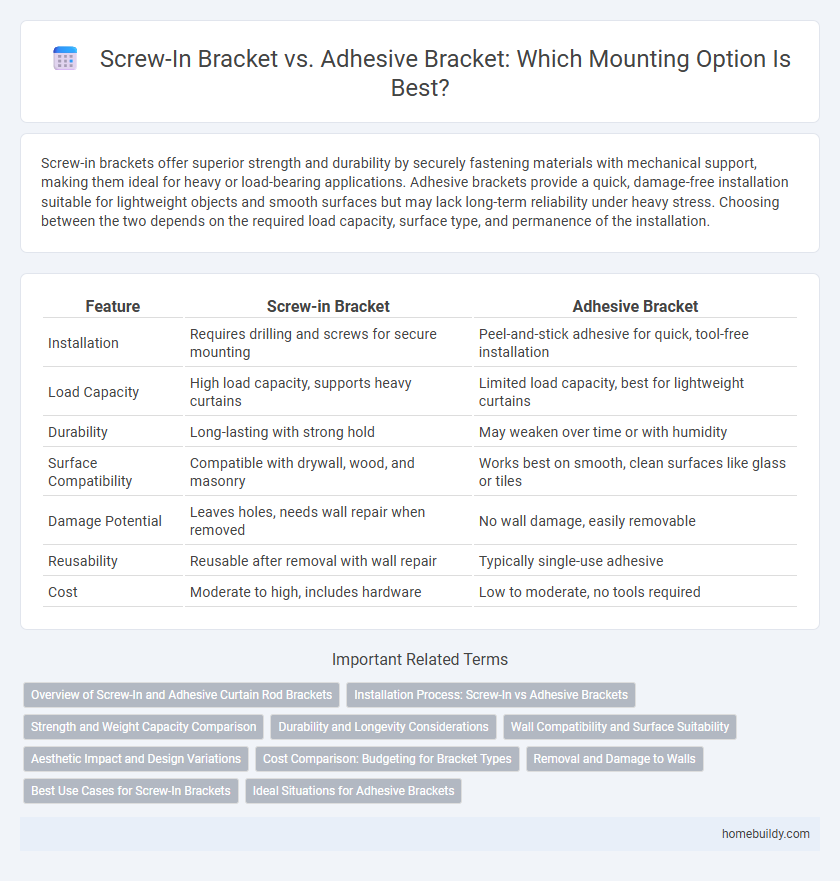Screw-in brackets offer superior strength and durability by securely fastening materials with mechanical support, making them ideal for heavy or load-bearing applications. Adhesive brackets provide a quick, damage-free installation suitable for lightweight objects and smooth surfaces but may lack long-term reliability under heavy stress. Choosing between the two depends on the required load capacity, surface type, and permanence of the installation.
Table of Comparison
| Feature | Screw-in Bracket | Adhesive Bracket |
|---|---|---|
| Installation | Requires drilling and screws for secure mounting | Peel-and-stick adhesive for quick, tool-free installation |
| Load Capacity | High load capacity, supports heavy curtains | Limited load capacity, best for lightweight curtains |
| Durability | Long-lasting with strong hold | May weaken over time or with humidity |
| Surface Compatibility | Compatible with drywall, wood, and masonry | Works best on smooth, clean surfaces like glass or tiles |
| Damage Potential | Leaves holes, needs wall repair when removed | No wall damage, easily removable |
| Reusability | Reusable after removal with wall repair | Typically single-use adhesive |
| Cost | Moderate to high, includes hardware | Low to moderate, no tools required |
Overview of Screw-In and Adhesive Curtain Rod Brackets
Screw-in curtain rod brackets provide superior stability by securely anchoring into wall studs or drywall, supporting heavier curtains and enduring long-term use. Adhesive brackets offer a damage-free installation option ideal for lightweight curtains and rental spaces, relying on strong, weather-resistant adhesives for temporary mounting. Choosing between these brackets depends on curtain weight, wall surface, and installation permanence requirements.
Installation Process: Screw-In vs Adhesive Brackets
Screw-in curtain rod brackets require drilling holes into the wall, ensuring a secure and long-lasting hold ideal for heavy or large curtains. Adhesive brackets offer a tool-free installation, using strong glue to stick onto smooth surfaces, suited for lighter curtains and temporary setups. The screw-in method demands more time and precision but delivers superior durability, while adhesive brackets provide convenience and damage-free removal.
Strength and Weight Capacity Comparison
Screw-in curtain rod brackets offer superior strength and support, reliably holding heavier curtains and withstanding greater weight capacities compared to adhesive brackets. Adhesive brackets are designed for lightweight curtains and may fail under substantial load or over time due to adhesive weakening. For heavy or long curtains, screw-in brackets ensure stability and durability, making them the preferred choice for robust window treatments.
Durability and Longevity Considerations
Screw-in curtain rod brackets offer superior durability and longevity due to their firm anchoring into wall studs or drywall, providing robust support for heavy curtains without risk of falling. Adhesive brackets may be easier to install but generally lack the long-term strength, as adhesives can weaken over time from humidity, temperature changes, or weight stress, leading to potential detachment. For sustained performance and heavier window treatments, screw-in brackets remain the preferred choice for stability and durability.
Wall Compatibility and Surface Suitability
Screw-in curtain rod brackets provide strong support and stability, making them ideal for walls made of drywall, wood, or masonry where screws can securely anchor. Adhesive brackets suit smooth, non-porous surfaces like glass, metal, or tile, but they are less reliable on textured or porous walls and may fail under heavy curtain weights. Choosing the right bracket depends heavily on the surface type and wall material to ensure durability and proper installation.
Aesthetic Impact and Design Variations
Screw-in curtain rod brackets offer a secure and durable installation, allowing for a wide range of design variations, including ornate metal finishes and robust profiles that contribute to an elegant aesthetic impact. Adhesive brackets provide a minimalist appearance with no visible hardware, ideal for lightweight curtains and modern, sleek interiors but typically limit design options due to weight restrictions. Choosing between these brackets depends on the desired balance between decorative appeal and installation strength, influencing both the visual outcome and practical functionality.
Cost Comparison: Budgeting for Bracket Types
Screw-in brackets generally cost more upfront due to hardware expenses but offer superior durability and long-term value. Adhesive brackets are often cheaper initially, making them ideal for budget-conscious projects or temporary installations, though they may require replacement sooner. Budgeting should consider installation environment and longevity needs to balance initial cost against potential maintenance.
Removal and Damage to Walls
Screw-in curtain rod brackets offer a secure and sturdy hold but can leave noticeable holes and potential damage to drywall upon removal, often requiring patching and repainting. Adhesive brackets minimize wall damage since they rely on strong, removable adhesives, but may lose adhesion over time and are less reliable for supporting heavy curtains. Choosing between the two depends largely on wall type, weight of curtains, and willingness to repair post-removal.
Best Use Cases for Screw-In Brackets
Screw-in curtain rod brackets provide superior strength and durability, making them ideal for heavy or long curtain rods, especially in high-traffic areas or rooms with large windows. They securely anchor into wall studs or drywall, ensuring stability and preventing sagging, which is crucial for supporting heavy drapery fabrics like velvet or thermal curtains. This type of bracket is best suited for permanent installations where long-term reliability and load-bearing capacity are essential.
Ideal Situations for Adhesive Brackets
Adhesive brackets are ideal for lightweight curtains and surfaces that cannot be drilled, such as drywall or glass. These brackets provide a damage-free installation option, making them perfect for renters or temporary setups. They excel in environments where quick, easy mounting is prioritized without compromising wall integrity.
Screw-in bracket vs adhesive bracket Infographic

 homebuildy.com
homebuildy.com